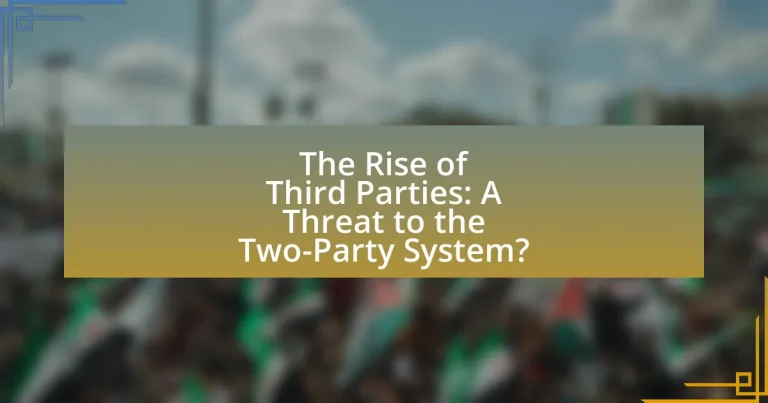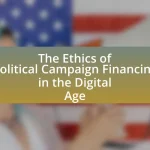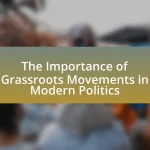The article examines the role and impact of third parties within the political landscape, particularly in relation to the dominant two-party system in the United States. It outlines how third parties represent alternative ideologies, influence policy debates, and provide voters with more choices, while also highlighting historical examples of their emergence and challenges faced, such as structural barriers and limited funding. The discussion includes the factors contributing to the rise of third parties, their potential to disrupt traditional voting patterns, and the implications for future electoral dynamics and political discourse. Additionally, it explores strategies that third parties can employ to enhance their visibility and influence in a predominantly two-party system.
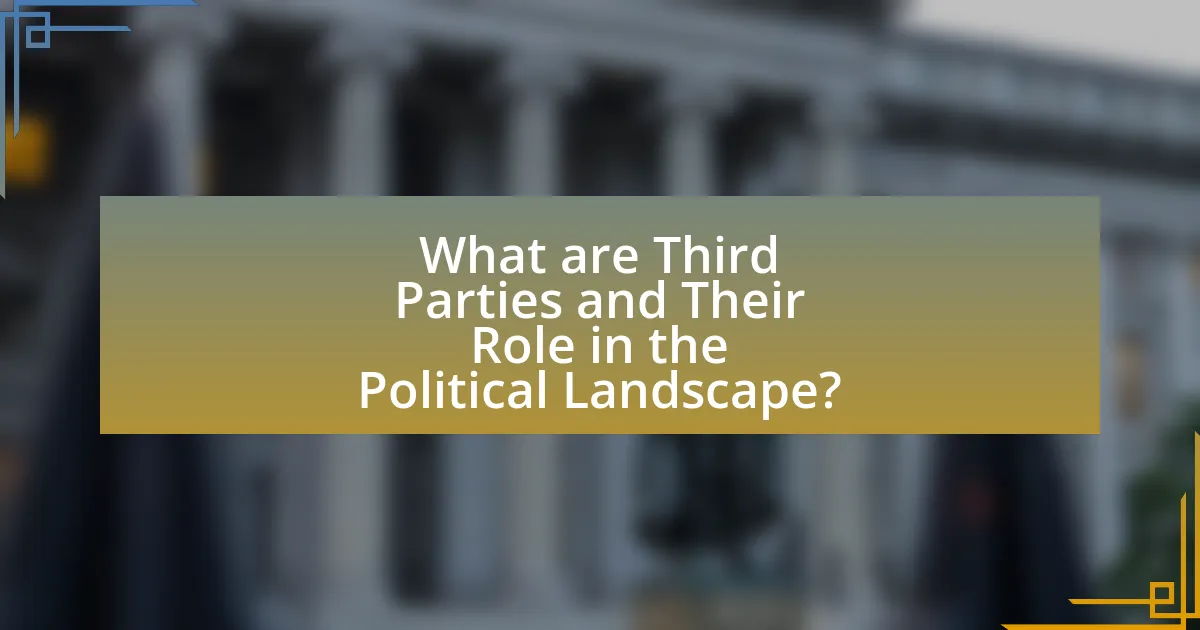
What are Third Parties and Their Role in the Political Landscape?
Third parties are political organizations that operate alongside the dominant two-party system, typically representing alternative ideologies or interests. Their role in the political landscape includes influencing policy debates, providing voters with more choices, and challenging the status quo established by the major parties. Historically, third parties like the Progressive Party in the early 20th century and the Green Party in recent decades have highlighted issues often overlooked by Democrats and Republicans, such as environmental concerns and social justice. Their presence can lead to shifts in voter alignment and compel major parties to adopt new policies to retain support, thereby impacting electoral outcomes and legislative agendas.
How do Third Parties differ from the Two-Party System?
Third parties differ from the two-party system primarily in their representation and electoral impact. While the two-party system, exemplified by the dominance of the Democratic and Republican parties in the United States, typically simplifies voter choice and consolidates political power, third parties often represent specific ideologies or interests that are not adequately addressed by the major parties. For instance, the Green Party focuses on environmental issues, while the Libertarian Party emphasizes individual liberties and limited government. Historically, third parties have struggled to gain significant traction in elections due to winner-takes-all electoral systems, which favor larger parties, as evidenced by the fact that no third-party candidate has won a presidential election in the U.S. since 1850. This structural disadvantage highlights the fundamental differences in how third parties operate compared to the entrenched two-party system.
What historical context has shaped the emergence of Third Parties?
The emergence of third parties in the United States has been shaped by historical contexts such as political dissatisfaction, social movements, and electoral reforms. Political dissatisfaction arose from the perceived failures of the two major parties to address issues like civil rights, economic inequality, and environmental concerns, leading to the formation of parties like the Green Party and the Reform Party. Social movements, including the labor movement and civil rights movement, have also catalyzed the rise of third parties by mobilizing voters around specific issues that mainstream parties often overlook. Additionally, electoral reforms, such as the introduction of proportional representation in some states, have provided opportunities for third parties to gain traction and influence, as seen in the success of the Libertarian Party in local elections. These factors collectively illustrate how historical contexts have fostered the emergence of third parties as alternatives to the dominant two-party system.
What are the key characteristics of Third Parties?
Third parties are political entities that operate alongside the dominant two-party system, characterized by their distinct platforms, ideologies, and voter bases. They often emerge to address specific issues that are overlooked by the major parties, such as environmental concerns or social justice, thereby attracting voters who feel unrepresented. Historically, third parties have influenced elections by drawing votes away from major candidates, as seen in the 1992 U.S. presidential election when Ross Perot’s candidacy garnered nearly 19% of the popular vote, impacting the outcome between George H.W. Bush and Bill Clinton. Additionally, third parties can serve as a catalyst for change by introducing new ideas into the political discourse, which can eventually be adopted by the larger parties.
Why are Third Parties gaining traction in recent elections?
Third parties are gaining traction in recent elections due to increasing voter dissatisfaction with the traditional two-party system. This dissatisfaction is reflected in polls indicating that a significant portion of the electorate feels unrepresented by the major parties, with surveys showing that around 60% of voters express a desire for more choices beyond Democrats and Republicans. Additionally, the rise of social media has enabled third parties to reach wider audiences and mobilize grassroots support more effectively, as evidenced by the increased visibility of candidates from parties like the Libertarian and Green parties in recent election cycles.
What social and political factors contribute to the rise of Third Parties?
Social and political factors contributing to the rise of Third Parties include voter dissatisfaction with the existing two-party system, the emergence of new social movements, and demographic shifts. Voter dissatisfaction often stems from perceptions that major parties do not adequately represent diverse interests or address pressing issues, leading to increased support for alternative parties. Additionally, social movements, such as those advocating for environmental issues or social justice, can galvanize public support for Third Parties that align with these causes. Demographic shifts, including changes in age, race, and education levels, also influence political preferences, as younger and more diverse voters may seek representation outside traditional party lines. Historical examples, such as the rise of the Green Party in the 1990s, illustrate how these factors can lead to significant electoral gains for Third Parties.
How do voter demographics influence Third Party support?
Voter demographics significantly influence Third Party support by shaping the preferences and priorities of different groups. For instance, younger voters, who tend to prioritize issues like climate change and social justice, are more likely to support Third Parties that align with these values, such as the Green Party. Additionally, demographic factors such as education level and urban versus rural residency impact Third Party appeal; educated urban voters often lean towards progressive Third Parties, while rural voters may gravitate towards more conservative alternatives. According to a 2020 Pew Research Center study, 49% of voters aged 18-29 expressed support for Third Parties, highlighting the importance of age demographics in this context. Thus, the intersection of age, education, and geographic location plays a crucial role in determining the level of support for Third Parties.
What challenges do Third Parties face in the current political system?
Third parties face significant challenges in the current political system, primarily due to structural barriers, limited funding, and media bias. Structural barriers include the winner-takes-all electoral system, which discourages votes for third parties since only candidates from the two dominant parties are likely to win. Limited funding restricts third parties’ ability to compete effectively; for instance, the Federal Election Commission’s regulations favor established parties, making it difficult for new entrants to gain financial support. Media bias further exacerbates the situation, as mainstream media often overlooks third-party candidates, reducing their visibility and public awareness. These factors collectively hinder third parties from gaining traction in a political landscape dominated by two major parties.
How do electoral laws impact Third Party viability?
Electoral laws significantly impact Third Party viability by shaping the competitive landscape in which these parties operate. For instance, winner-takes-all electoral systems, commonly used in the United States, discourage votes for Third Parties because voters often perceive them as unlikely to win, leading to strategic voting for major parties. This is evidenced by the fact that in the 2020 U.S. presidential election, Third Party candidates received only about 1.2% of the total votes, illustrating the challenges posed by such electoral frameworks. Additionally, stringent ballot access laws can further limit Third Party participation, as seen in states with high signature requirements that make it difficult for these parties to appear on ballots. Consequently, the structure of electoral laws directly influences the ability of Third Parties to gain traction and compete effectively against established parties.
What are the financial obstacles for Third Parties?
Third parties face significant financial obstacles, primarily due to limited access to funding and resources compared to established parties. These obstacles include challenges in raising campaign contributions, as major donors often prefer to support candidates from the two dominant parties, which are perceived as having a higher chance of winning. Additionally, third parties frequently struggle with high costs associated with ballot access, which can require substantial financial investment to meet state-specific requirements. According to the National Conference of State Legislatures, over 30 states have stringent ballot access laws that can financially burden third-party candidates. Furthermore, third parties often lack the infrastructure and organizational support that larger parties possess, making it difficult to compete effectively in fundraising and campaign expenditures.
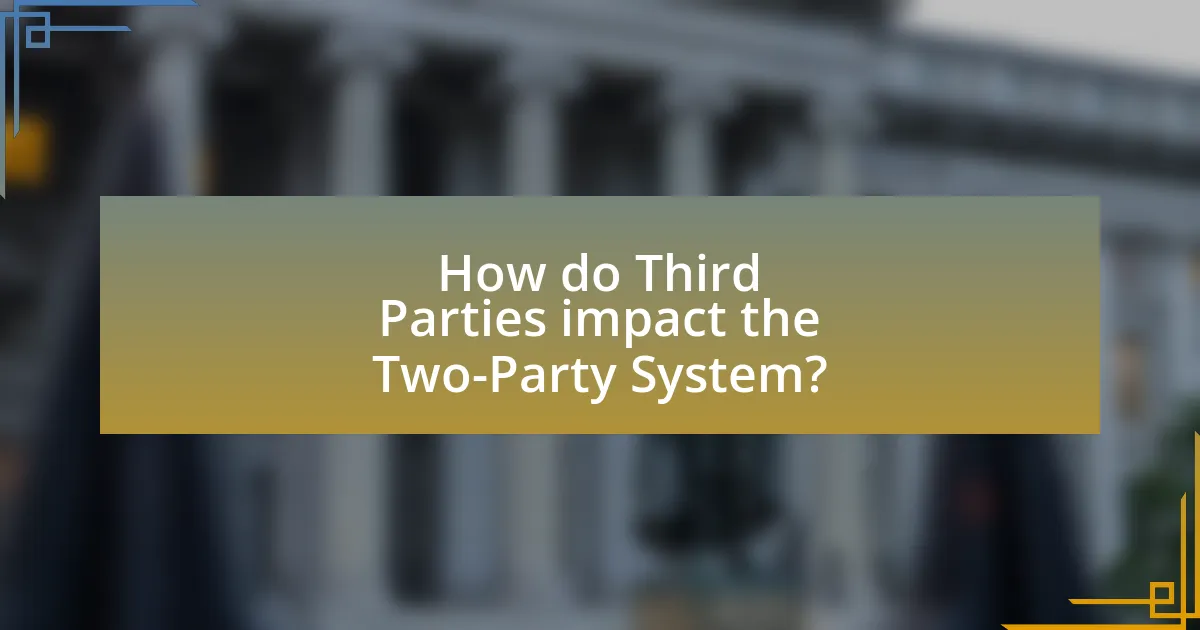
How do Third Parties impact the Two-Party System?
Third parties impact the two-party system by introducing alternative viewpoints and influencing electoral outcomes. They can siphon votes away from major parties, as seen in the 1992 presidential election when Ross Perot, running as an independent, garnered 19% of the popular vote, which many analysts believe affected the outcome between Bill Clinton and George H.W. Bush. Additionally, third parties can push major parties to adopt new policies or address issues they might otherwise ignore, as demonstrated by the Green Party’s emphasis on environmental issues, which has led to increased focus on climate change within the Democratic Party. Overall, third parties challenge the dominance of the two-party system by reshaping political discourse and electoral dynamics.
What are the potential threats posed by Third Parties to the Two-Party System?
Third parties pose several potential threats to the two-party system, primarily by siphoning votes, altering electoral outcomes, and challenging the dominance of established parties. When third parties gain traction, they can split the vote among similar ideological candidates, which can lead to the election of candidates from opposing parties who may not reflect the preferences of the majority. For instance, in the 2000 U.S. presidential election, Ralph Nader’s candidacy as a Green Party candidate is often cited as having drawn votes away from Al Gore, contributing to George W. Bush’s victory. Additionally, third parties can introduce new issues into the political discourse, forcing the two major parties to adapt or risk losing relevance. This dynamic can destabilize the traditional political landscape, as seen in various elections where third-party candidates have influenced policy discussions and voter priorities.
How can Third Parties influence election outcomes?
Third parties can influence election outcomes by siphoning votes away from major party candidates, thereby altering the dynamics of the election. For instance, in the 2000 U.S. presidential election, Ralph Nader’s candidacy with the Green Party is often cited as a factor that contributed to Al Gore losing to George W. Bush, as Nader received approximately 2.7% of the popular vote, which many analysts believe would have otherwise gone to Gore. Additionally, third parties can introduce new issues into the political discourse, compelling major parties to address these topics to retain voter support. This influence can lead to shifts in party platforms and voter alignment, as seen with the rise of the Libertarian Party advocating for civil liberties and reduced government intervention, which has prompted discussions within the Republican Party.
What historical examples illustrate Third Parties disrupting the Two-Party System?
Historical examples illustrating Third Parties disrupting the Two-Party System include the emergence of the Progressive Party in the early 20th century and the impact of Ross Perot’s candidacy in the 1992 presidential election. The Progressive Party, led by Theodore Roosevelt in 1912, garnered 27.4% of the popular vote, significantly affecting the election outcome by splitting the Republican vote, which allowed Democrat Woodrow Wilson to win. Similarly, Ross Perot, running as an independent candidate in 1992, received 18.9% of the popular vote, drawing support primarily from disillusioned voters of both major parties and influencing the election dynamics, ultimately benefiting Bill Clinton’s victory over incumbent George H.W. Bush. These instances demonstrate how Third Parties can disrupt traditional voting patterns and alter the results of elections within a predominantly two-party system.
In what ways can Third Parties contribute positively to the political discourse?
Third parties can contribute positively to political discourse by introducing diverse viewpoints and fostering debate on issues often overlooked by the dominant parties. They challenge the status quo, encouraging major parties to address a broader range of concerns, which can lead to more comprehensive policy discussions. For instance, the Green Party has successfully brought environmental issues to the forefront of political conversations, influencing mainstream parties to adopt more sustainable policies. Additionally, third parties can mobilize voter engagement by appealing to disenfranchised groups, thereby increasing overall political participation and representation. Historical examples, such as the impact of Ross Perot’s candidacy in the 1992 election, demonstrate how third parties can shift the political landscape and compel major parties to reconsider their platforms.
How do Third Parties promote new ideas and policies?
Third parties promote new ideas and policies by introducing alternative platforms that challenge the dominant narratives of major political parties. They often focus on specific issues that are overlooked or underrepresented, such as environmental concerns, social justice, or economic reform. For example, the Green Party has successfully brought environmental issues to the forefront of political discourse, influencing mainstream parties to adopt more sustainable policies. Additionally, third parties can act as a catalyst for change by mobilizing grassroots movements and engaging voters who feel disenfranchised by the two-party system, thereby expanding the political dialogue and encouraging broader participation in the democratic process.
What role do Third Parties play in voter engagement and participation?
Third parties play a significant role in enhancing voter engagement and participation by providing alternative choices to the dominant two-party system. They often attract disenchanted voters who feel unrepresented by major parties, thereby increasing overall electoral participation. For instance, during the 2016 U.S. presidential election, candidates from third parties like the Libertarian Party and the Green Party garnered approximately 5% of the popular vote, illustrating their ability to mobilize voters who might otherwise abstain. This engagement can lead to higher voter turnout, as third parties often focus on specific issues that resonate with particular demographics, encouraging those groups to participate in the electoral process.
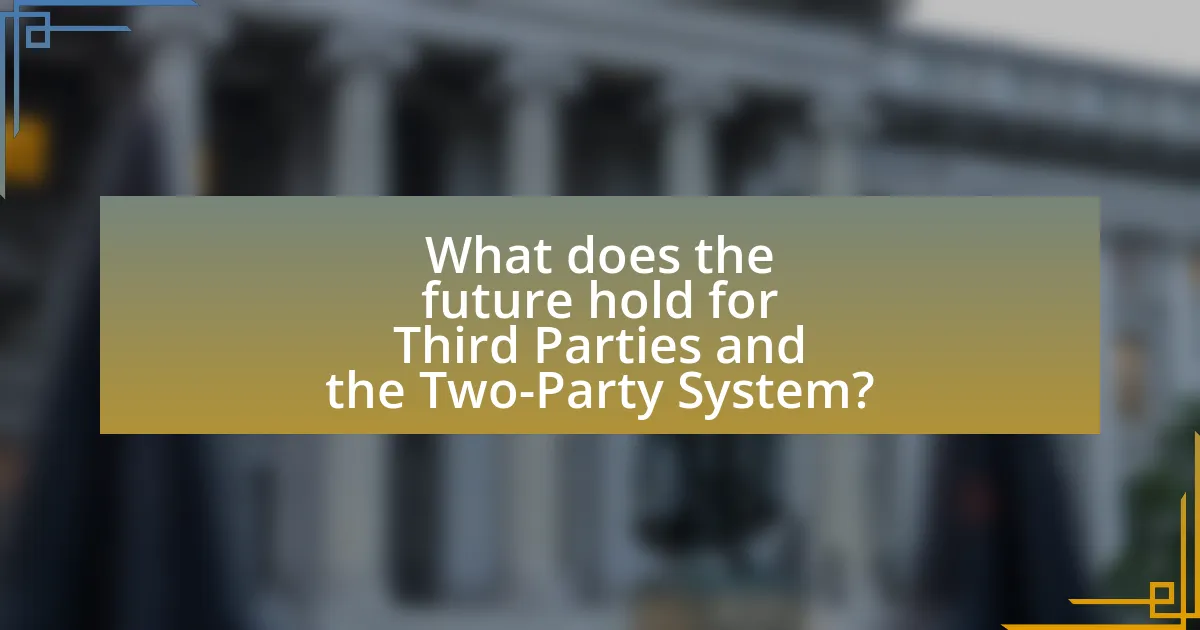
What does the future hold for Third Parties and the Two-Party System?
The future for third parties within the two-party system is likely to see increased visibility and influence, but significant challenges remain. Historical trends indicate that third parties often struggle to gain traction due to systemic barriers such as winner-takes-all electoral systems, which favor established parties. For instance, in the 2020 U.S. presidential election, third-party candidates collectively received about 3% of the vote, illustrating their limited impact on major outcomes. However, growing public dissatisfaction with traditional parties may lead to more support for third-party platforms, as seen in recent elections where issues like climate change and social justice have gained prominence. This suggests that while third parties may not dismantle the two-party system, they could reshape political discourse and influence policy agendas in the future.
How might the political landscape evolve with the rise of Third Parties?
The political landscape may evolve significantly with the rise of Third Parties by increasing electoral competition and diversifying political representation. As Third Parties gain traction, they can challenge the dominance of the traditional two-party system, leading to a more pluralistic political environment. Historical examples, such as the impact of Ross Perot’s candidacy in the 1992 presidential election, demonstrate how Third Parties can siphon votes from major parties, potentially altering election outcomes. Additionally, the presence of Third Parties can encourage major parties to adopt more varied platforms to appeal to a broader electorate, reflecting a wider range of public interests and concerns.
What trends indicate a shift towards a multi-party system?
Trends indicating a shift towards a multi-party system include increasing voter dissatisfaction with traditional parties, the rise of independent candidates, and the emergence of niche parties that address specific issues. Voter dissatisfaction is evidenced by declining approval ratings for major parties, with a Gallup poll showing that only 25% of Americans expressed confidence in the two-party system in 2021. The rise of independent candidates is reflected in the growing number of voters identifying as independents, which reached 41% in 2020 according to the Pew Research Center. Additionally, niche parties, such as the Green Party and Libertarian Party, have gained traction by focusing on specific issues like environmental policy and personal freedoms, respectively, indicating a diversification of political representation.
How can the Two-Party System adapt to the challenges posed by Third Parties?
The Two-Party System can adapt to the challenges posed by Third Parties by incorporating more inclusive policies and addressing the specific issues that Third Parties highlight. By recognizing and integrating the concerns raised by Third Parties, such as social justice, environmental issues, and economic inequality, the established parties can broaden their appeal and retain voter support. Historical evidence shows that in response to the rise of Third Parties, such as the Reform Party in the 1990s, major parties have shifted their platforms to include more progressive stances on key issues, thereby mitigating the threat posed by these alternative political movements. This adaptability can help maintain the relevance of the Two-Party System in a changing political landscape.
What strategies can Third Parties employ to enhance their impact?
Third parties can enhance their impact by focusing on grassroots mobilization, strategic alliances, and leveraging digital platforms. Grassroots mobilization allows third parties to build a strong base of support through community engagement and local activism, which has been shown to increase voter turnout and awareness. Strategic alliances with like-minded organizations can amplify their message and resources, as evidenced by the collaboration between the Green Party and other environmental groups to promote sustainability initiatives. Additionally, leveraging digital platforms for outreach and fundraising enables third parties to reach a broader audience and engage younger voters, as demonstrated by the success of various campaigns that utilized social media effectively to mobilize support.
How can Third Parties effectively mobilize grassroots support?
Third parties can effectively mobilize grassroots support by leveraging community engagement strategies and utilizing digital platforms for outreach. Engaging local communities through town halls, workshops, and volunteer initiatives fosters personal connections and builds trust. Additionally, utilizing social media and online organizing tools allows third parties to reach a broader audience, facilitating communication and mobilization efforts. For instance, the Green Party successfully used social media campaigns to increase visibility and support during elections, demonstrating the effectiveness of these strategies in grassroots mobilization.
What best practices can Third Parties adopt to increase their visibility and influence?
Third parties can increase their visibility and influence by leveraging digital platforms for outreach and engagement. Utilizing social media channels allows third parties to connect with a broader audience, share their messages, and mobilize supporters effectively. For instance, a study by the Pew Research Center found that 69% of adults in the U.S. use social media, making it a critical tool for political communication. Additionally, forming coalitions with like-minded organizations can amplify their reach and credibility, as demonstrated by the success of various grassroots movements that have united diverse groups around common goals. Engaging in local community events and forums also enhances visibility, as it allows third parties to interact directly with constituents and address their concerns, fostering a sense of trust and relatability.
